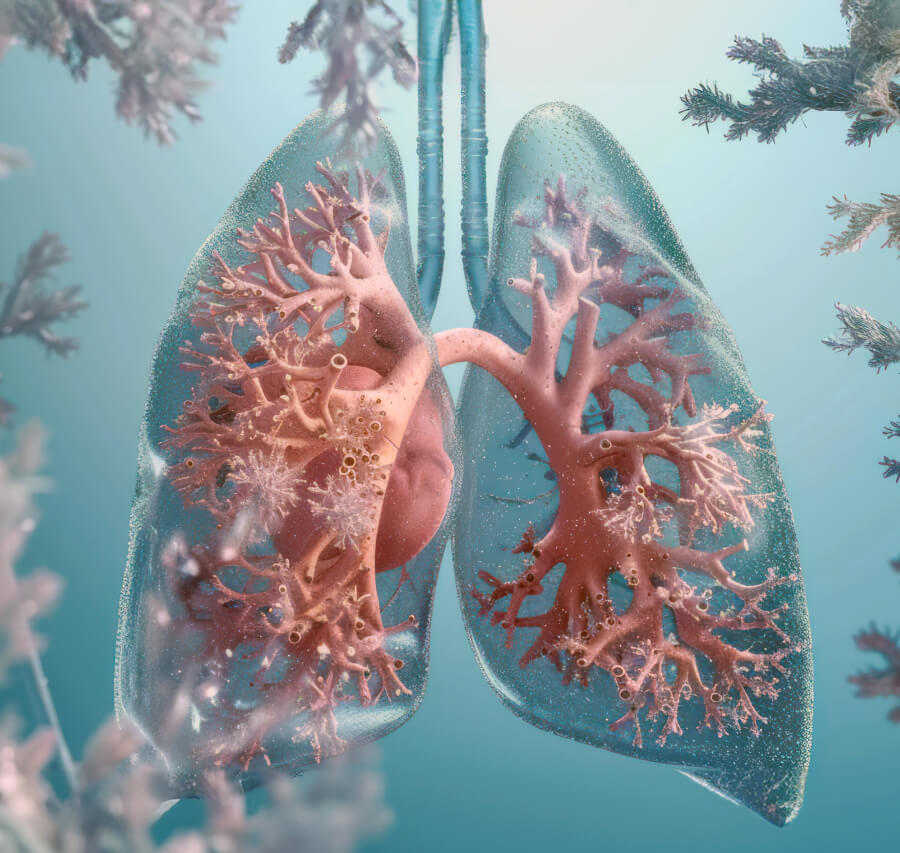Imagine taking a journey inside your lungs, past branching airways like miniature highways, until you reach the ultimate destination: millions of tiny, balloon-like chambers called alveoli.
These unassuming heroes are the lungs’ powerhouses, responsible for the essential dance of life – gas exchange.
Today, we’ll delve into their remarkable structure, function, and some potential threats lurking in our polluted world.
Picture this: each lung holds around 300 million alveoli, boasting a combined surface area exceeding a tennis court! Each alveolus resembles a hollow sphere, lined with specialized cells.
One type, the alveolar epithelial cells, act as gatekeepers, allowing oxygen to diffuse from inhaled air into the bloodstream.
Meanwhile, carbon dioxide, our cellular waste product, makes its way out.
This seamless transfer happens thanks to a marvel of evolution – an incredibly thin barrier between air and blood, just about the width of a few cells!
What Are Alveoli?
Alveoli, though diminutive in size, wield immense power.
Picture them as the diligent workers in your lung factory, tirelessly ensuring that oxygen reaches your bloodstream and carbon dioxide exits your body.
Here’s a closer look:
They are arranged in clusters, with each cluster forming an alveolar sac.
They are closely packed, resembling grapes in a cluster. The abundance of alveoli and alveolar sacs contributes to the spongy texture of the lungs. Each individual alveolus measures approximately 200 micrometers (µm) or 0.007 centimeters (cm) in diameter.
Each alveolus has a cup-like shape with extremely thin walls, and it is encircled by delicate capillary networks with similarly thin walls.
Location
Imagine your lungs as two sprawling forests. At the end of each bronchial branch, you’ll find clusters of alveoli—like dew-kissed leaves on a tree. These tiny sacs are where the magic happens.
Numbers Game
Brace yourself for this mind-boggling fact: You harbor approximately 480 million alveoli!
Collectively, they unfurl over 1,399 square feet (or 130 square meters) of surface area. That’s like having a secret oxygen exchange party in your chest!
Alveoli are tiny, balloon-shaped air sacs located at the end of the bronchioles in the lungs.
They are the primary site of gas exchange in the respiratory system, where oxygen from the air is absorbed into the bloodstream and carbon dioxide, a waste product of metabolism, is released from the bloodstream into the lungs to be exhaled.
The walls of the alveoli are thin and lined with a network of capillaries, allowing for efficient exchange of gases between the air and the bloodstream through a process called diffusion.
This exchange of gases is essential for the body to obtain oxygen for cellular respiration and to expel carbon dioxide, which is produced as a byproduct of cellular metabolism.
How does it work?
Each alveolus (singular of alveoli) measures a mere 200 micrometers in diameter—so delicate that a butterfly landing would feel like an earthquake.
These sacs are encircled by a web of capillaries, forming a cozy neighborhood. Oxygen and carbon dioxide exchange glances through their thin walls.
Imagine alveoli as bustling market stalls: oxygen checks in, carbon dioxide checks out. It’s a perpetual transaction.
Alveoli work through a process called gas exchange, which involves the movement of oxygen and carbon dioxide between the air in the lungs and the bloodstream.
Here’s 6 steps for how it works:
- Oxygen from the air enters the lungs when we inhale. It travels down the airways (bronchi and bronchioles) until it reaches the alveoli.
- In the alveoli, oxygen molecules diffuse across the thin walls of the air sacs and into the surrounding capillaries. This process is driven by the difference in partial pressure of oxygen between the air in the alveoli and the blood in the capillaries.
- Once in the bloodstream, oxygen binds to hemoglobin molecules in red blood cells, which are then carried throughout the body to deliver oxygen to cells for cellular respiration.
- At the same time, carbon dioxide, a waste product of cellular metabolism, diffuses from the capillaries into the alveoli. Carbon dioxide is transported in the bloodstream in the form of bicarbonate ions or bound to hemoglobin.
- When we exhale, carbon dioxide-rich air is expelled from the alveoli into the airways and eventually out of the body.
- This continuous exchange of oxygen and carbon dioxide in the alveoli is vital for maintaining the proper levels of these gases in the bloodstream, which is necessary for cellular function and overall health.
Threats in the Air: Protecting our Alveolar Allies
Unfortunately, this delicate dance can be disrupted by various lung disorders. Let’s explore some common culprits:.
Infections
Bacteria and viruses can invade the alveoli, causing pneumonia, which can be life-threatening, especially for infants and older adults.
Smoking
Cigarettes unleash a toxic cocktail of chemicals that damage the alveoli, leading to emphysema, a condition where the air sacs lose their elasticity.
As per information provided by the U.S. Centers for Disease Control and Prevention (CDC), tobacco smoke inflicts damage upon the lungs, resulting in various lung conditions such as chronic obstructive pulmonary disease (COPD), emphysema, and chronic bronchitis. The irritants present in tobacco smoke affect both the bronchioles and alveoli, causing harm to the lining of the lungs.
This damage accumulates over time, leading to scarring of lung tissue that impairs the efficient exchange of oxygen and carbon dioxide. Regrettably, the harm caused by smoking is irreversible.
Pollution
Indoor pollutants, including secondhand smoke, mold, dust, household chemicals, radon, and asbestos, pose significant threats to lung health, exacerbating existing lung diseases. Likewise, outdoor pollution stemming from vehicular and industrial emissions also contributes to lung damage.
Disease
Chronic smoking is a well-established contributor to lung disease, although other factors such as genetics, infections, or compromised immune systems can also play a role. Treatments like chemotherapy and radiation for cancer may further exacerbate lung issues. Lung diseases manifest in various forms, all of which impact breathing. Some common examples include chronic obstructive pulmonary disease (COPD), asthma, idiopathic pulmonary fibrosis, lung cancer, and pneumonia.
Aging:
The natural aging process can diminish respiratory function, resulting in reduced lung capacity and weakened chest muscles. Additionally, older individuals are at higher risk for bacterial and viral pneumonia.
Maintaining Alveoli and Lung Health:
To safeguard lung health, it’s crucial to limit exposure to pollutants. Employing air purifiers in indoor environments and monitoring outdoor air quality can mitigate risks.
Smoking cessation is paramount for preserving lung health, with various resources available to support individuals in quitting, including nicotine replacement therapy, support groups, and online blogs dedicated to smoking cessation.
So How can we Safeguard these Lung Superheroes?
Embrace the Green: Reduce air pollution by choosing cleaner transportation, avoiding burning firewood, and supporting green initiatives.
Kick the Habit: Quitting smoking is the single most important step to protect your lungs.
Mask Up When Needed: Wearing a mask in polluted areas or during peak allergy season can help filter out harmful particles.
Strengthen Your Defense: Maintain a healthy lifestyle with a balanced diet, regular exercise, and adequate sleep to boost your immune system.
Conclusion:
In summary, alveoli play a crucial role in the respiratory system by facilitating the exchange of oxygen and carbon dioxide between the air we breathe and our bloodstream.
Their unique structure, with thin walls and extensive capillary networks, enables efficient gas exchange, ensuring that our cells receive the oxygen they need for metabolism while removing carbon dioxide waste.
Understanding the function and structure of alveoli is essential for appreciating the complexity of the respiratory system and the importance of maintaining lung health.
FAQs
What is the primary function of alveoli?
The primary function of alveoli is to facilitate gas exchange, allowing oxygen from the air to enter the bloodstream and carbon dioxide to exit the bloodstream into the air.
How are alveoli structured?
Alveoli are small, balloon-like air sacs located at the ends of the bronchioles in the lungs. They have thin walls lined with a network of capillaries, which maximize the surface area available for gas exchange.
What are some common lung disorders involving alveoli?
Lung disorders involving alveoli include emphysema, bronchiolitis obliterans, and pulmonary fibrosis. These conditions can impair the function and structure of alveoli, leading to difficulties in breathing and decreased lung capacity.
How does smoking affect alveoli?
Smoking can damage the delicate walls of the alveoli, leading to conditions such as emphysema, where the alveoli become stretched and lose their elasticity. Smoking also increases the risk of developing lung cancer, which can further impair lung function.
Can alveolar damage be reversed?
In some cases, such as with quitting smoking or treating underlying conditions early, alveolar damage may be partially reversible. However, in advanced stages of lung disease, irreversible damage to the alveoli may occur.
How can I keep my alveoli healthy?
Maintaining a healthy lifestyle, including regular exercise, avoiding smoking and exposure to air pollutants, and following a balanced diet rich in fruits and vegetables, can help support lung health and preserve the function of alveoli. Regular check-ups with a healthcare provider can also help identify and address any potential lung issues early on.





